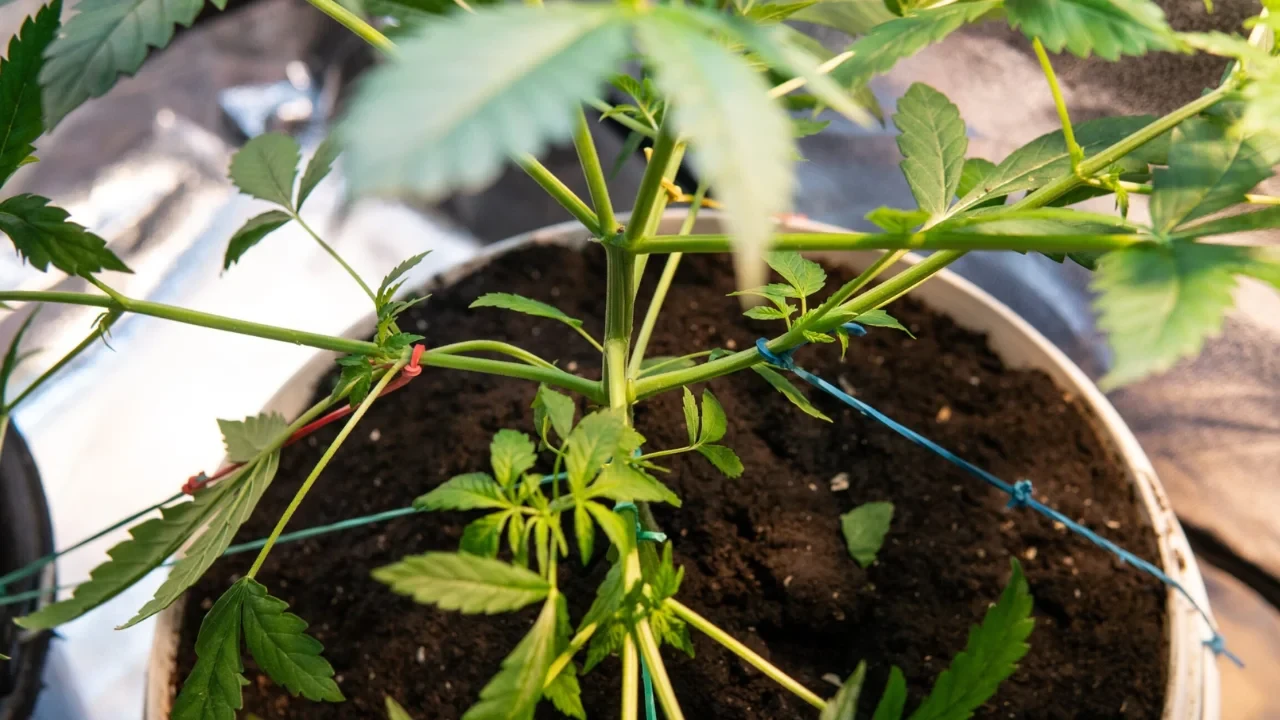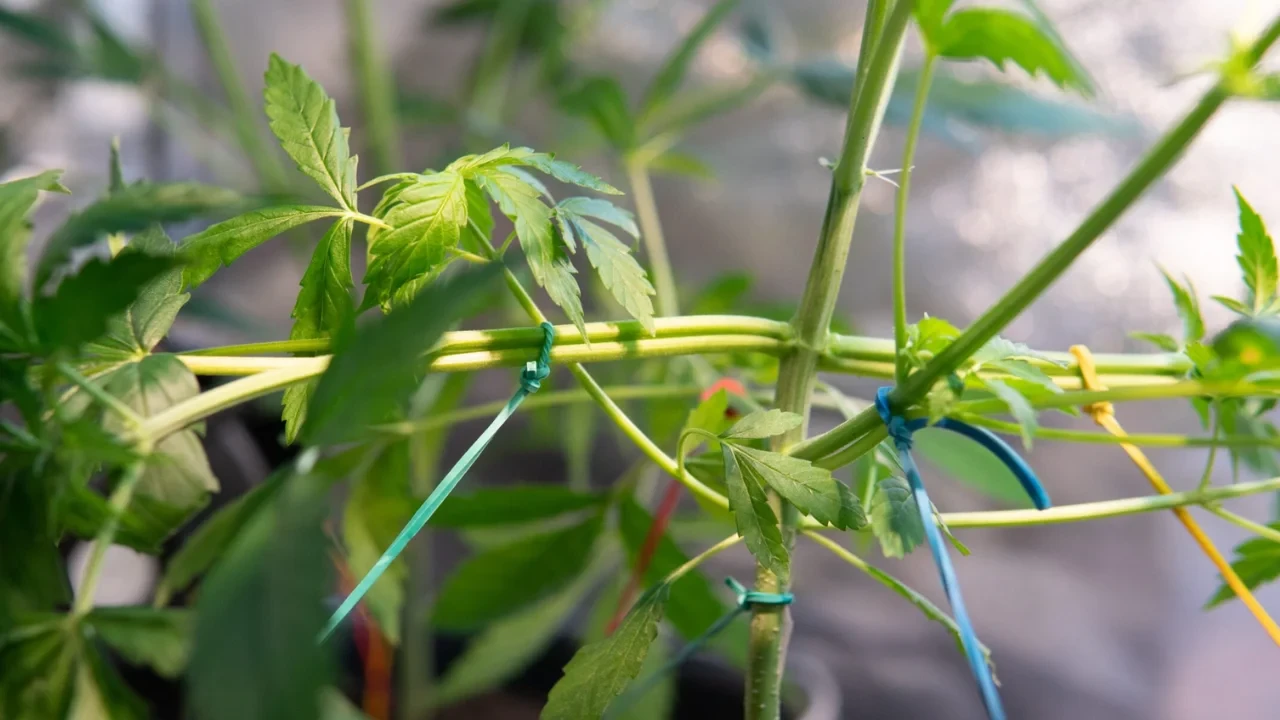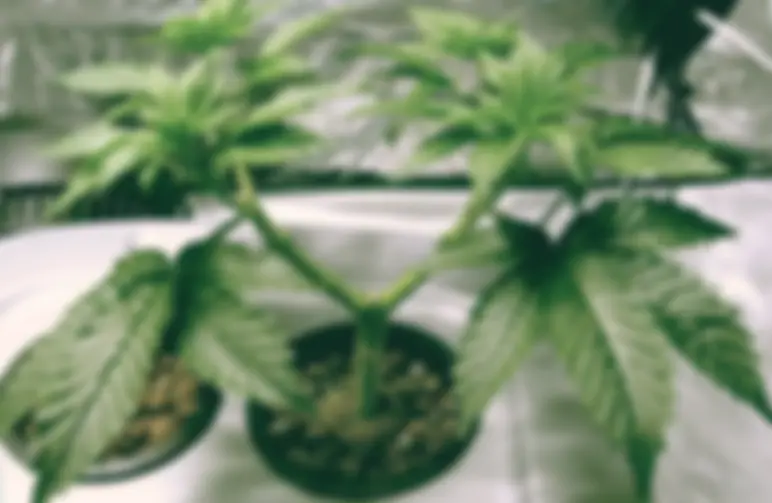Whether you are new to cannabis growing or have experience, you probably have considered mainlining. You might not know if the training technique is right for you, but there are plenty of advantages to enjoy.
This mainlining guide will teach you everything there is to know about the method. Grab your seeds and get ready for some big yields.
What Is Mainlining Weed?
In essence, mainlining, or manifolding, is a mixture of low-stress training, topping, and ScrOG. Growers use this hybrid method to grow multiple large, uniform colas. A part of the process involves bending stems and altering their lengths.
You would get the plant to form something called a manifold. A manifold is when you split the main cannabis stem so that it looks Y-shaped. As a result, there is a center for energy to go from the roots to each bud equally.
Nutrients and resources can go to different branches for better plant growth. Manifolds make mainlining so much more straightforward. Not to mention, the entire process can be cost-effective and easy for people of all experience levels.
Mainlining can create an even canopy. This training method can be used indoors and outdoors. Repeating the process a few times on newer growths can produce over a dozen plump buds.
Quick jump to:How to Mainline Cannabis

Advantages of Mainlining Cannabis
Mainlining marijuana has plenty of benefits to encourage growers to try it. For example, the method can feel effortless at times. However, the greatest advantage is the effect the technique has on your yield. The increased canopy size means you potentially get to harvest more.
Some strains already have the possibility of producing hundreds of grams worth of weed. Mainlining can bring the plant's harvest size to its absolute max. Of course, other factors during cultivation aid in yield size as well.
You only need to perform this method once or twice to start seeing multiple dense buds. Some growers can get up to 16 or even 32 colas. Instead of leafy "popcorn" buds, you can have most of them grow to a similar size and weight. Even fat colas help simplify the drying and curing processes.
Even if you have a smaller room size, you do not need to worry about a weak harvest. Mainlining can be your best friend in this case.
When Can You Mainline Cannabis?
You should start mainlining when your cannabis is 2-3 weeks into its vegetative phase. Ideally, the plant is sturdy enough when it has at least five nodes before you begin. A node is where the fan leaves stick out from the main stem. You can wait a bit if you feel like your marijuana is not growing fast enough.
Since the training technique involves some stress, it is best not to mainline marijuana too early. Young seedlings may not be able to handle it. On the other hand, you should avoid using this method when the flowering stage arrives.
The stems get stiff as the plant gets older, so the branches may snap when you try to bend them. Adding stress during this time can cause marijuana to take a step back and divert energy to other parts of the plant instead of blooming.
What Do You Need for Mainlining Weed Plants?
Mainlining weed is great for people who prefer minimalistic approaches. You do not need much equipment. The first thing you need to have is your plants ready to train. They should be free of any pests, deficiencies, fungi, and mould.
The hybrid training method is going to stress your plant out. A healthy state is necessary to ensure crops recover in time to grow and flower the best buds. Another item on the list is a sharp tool to top the plants. You can get pruning shears, scissors, or razor blades.
For mainlining, you will need some plant ties or other soft, bendy wire to hold down the branches. Several growers also use a tomato ring to control the growth of cannabis. You can get them from a store and modify them as needed.
How to Mainline Weed
After you have everything that you need, you can start training your weed to produce exceptional yields. For a successful mainlining session, what you have to do is:
1. Create a Manifold
The first thing you should do is create the central structure of mainlined marijuana. Begin by cutting down the plant to the third node from the base. Remove any additional growth tips that are below the third node for better energy distribution. Try to keep the leaves intact since they power the growth of your weed.
Now, the plant should have a Y-shaped structure. You will see two main shoots, and it is time to tie them down with plant ties. Try to keep them as parallel to the ground as possible to avoid snapping the young growths.
You can attach the other end of the ties to the edge of the pot to ensure the branches remain horizontal.
2. Topping the third node
Once you have a manifold, the branches will sprout new pairs of leaves. It can take a few weeks, but you need to wait for the stalks to grow 3-4 nodes each. Some growers begin topping their weed plants after they see a couple of new growth tips.
After the branches are long enough, take your pruning shears and cut them down to the third node on each stem. It is important to trim down to the same spot to keep the plant symmetrical. The transportation of nutrients can be efficient, and the entire cannabis can receive enough energy.
Avoid damaging the growth tips by the node since they will become new main stems. Now, you have four colas on your marijuana.
3. Remove the second node
Instead of removing all the growth under the third node, only cut off the second node on each stem. The growth on nodes one and three would remain intact. The plant can remain supported with more leaves, providing fuel for growth.
Some people trim off all the growth below the topping point and keep the leaves. However, you only really need to get rid of the tips on the second node. It is a helpful way to manage time while freeing up energy.
4. Repeat the Process
You should have eight shoots to work with now. You can repeat steps 2 and 3 as many times as you would like. Each time you top, you will have doubled the number of colas the plant has. You can go again for 16 branches or try for 32.
If you have a small growing room and multiple plants, eight or even 16 branches per cannabis might be enough. After all, you need to conserve space since the crops need room to breathe. Outdoor mainlining has more leeway, and you can repeat the method three or four times.
5. Check and Wait
In between toppings and afterward, check back in regularly to keep an eye on your weed. Make sure the ties keep the central stems and new shoots down. Adjust them if necessary to keep the stems parallel to the soil. Some growers secure the branches to a tomato ring, but it is optional.
All you need to do is wait for the plant to grow into a flat canopy. Uniformity is important, so check on the marijuana a couple of times a week to make any alterations. You will also want to keep an eye on its recovery from stress as well.
6. Take Care of Your Plants
As you wait for your crops to grow, make sure they get enough water, light, and nutrients after you finish mainlining. The plants will need the proper amount of energy to recover from the training technique.
Sometimes, a person might cause a tear or a crack in one of the stems. The damage could have happened when they cut off the nodes. Sometimes, the branches snap when you bend and secure them. Splits in the stems can have a negative effect on the weed's overall health.
However, you do not have to worry. Many growers have found that duct tape is a reliable bandage for any damage a plant sustains. Wrap some tape around the branch and wait a while. After a couple of weeks, check to see if the plant healed.
7. Switch to Flowering
Mainlining extends the vegetative stage by a few weeks. Switch to flowering when it is time to move on to the next phase. You can easily do this by changing how much light and darkness cannabis receives each day.
Indoors, the light conditions should be 12 hours under the bulbs. If you are outside, less than 13 hours of sunlight can trigger the flowering period. Make sure that you have finished any other training methods before switching to the next stage.
8. Grow Until Harvest
Continue managing your weed through the flowering stage as you would for un-mainlined plants. During the first couple of weeks, cannabis continues to grow and stretch. After a while, the plants will stop and focus on blooming their buds. Keep feeding them the appropriate nutrients.
In the latter half of the phase, keep an eye out for signs that it is time to harvest. Once cannabis is ripe, you can begin the process of removing the buds and drying them.

Mainlining Cannabis Tips
Patience Is Key
Mainlining takes several weeks to complete. On average, you can expect it to take 60-70 days for all the branches to grow out. The number of times you repeat the process can influence how long mainlining cannabis lasts.
It is important not to rush the process. Patience ensures that you make as few mistakes as possible. Before you know it, you will have a flat, even canopy with tons of colas.
Mainlining Is Not for Autoflowers
Similar to other training techniques, you should avoid mainlining autoflowers. The process requires multiple topping sessions. Cutting off nodes once can stress out autoflowers a lot, so mainlining would not be good for these strains.
Not to mention, the vegetative period for autoflowers tends to be shorter than the one for feminised and regular seeds. You might not have enough time to mainline and wait for them to recover.
Seeds Are Better Than Clones
While you can mainline clones, growers tend to have better results from seed-grown marijuana. Clones have a weaker root system, so they can be more vulnerable to the stress of the training method. You would need to take extra care when you are topping the nodes.
A suitable seed produces a plant that displays single-cola dominance. Clones usually do not have that characteristic, and they might appear asymmetrical. The structure is likely to be different when you mainline a clone compared to a seed.
If you want the best yields, seeds are the way to go.
Final Thoughts on Mainlining Weed
Anyone can try out mainlining, and the method is simple and inexpensive. If there are any cons, the benefits far outweigh them. You and your plants will be happy to undergo mainlining when the time is right.
If you plan to mainline, it is a good idea to get some seeds that are suitable for the process. As mentioned before, plants that show single-cola dominance tend to respond better. Indica strains generally have this trait. Additionally, your plants should naturally grow to a medium or tall height.





